


This only applies to live text, though, not any text that may appear in an image or that may have been converted to outlines. If you need to find out the typefaces that were used in the document, go to File > Properties > Fonts. It’s also helpful if a client sends you a PDF from another business that they like, for example, and they want to do something in that same size. This is particularly helpful when they have something like a direct mail package to proof. I tell clients about this feature so they can check the size of the pieces they are proofing. If you hover your cursor in the lower lefthand corner of the document window, you will see the page size. That can help them find the document on their end-meaning if it was in Word, they created it, but if it came from InDesign, they’ll need to ask their designer for the file. I’ve found this helpful in a few situations such as when the client said they weren’t sure what application the file was created in and I needed the original file. It will show you the application and the version, if it was created on a Mac or PC, the date it was created and modified, and much more. You can figure out which program the PDF was exported from by going to File > Properties and then Description. It comes from somewhere else- InDesign, Word, Excel, etc.

No one just creates a PDF and starts typing in it and adding images. You can find out where a PDF originated from.Ī PDF always comes from some other program. Let’s get into 11 cool Acrobat tips, tricks and features that will save you time or are just really cool. But there’s a lot more you can do with Acrobat that you may not know about. After all, you can export to PDF from any program, and PDF is cross-platform, so anyone can open it.


 0 kommentar(er)
0 kommentar(er)
